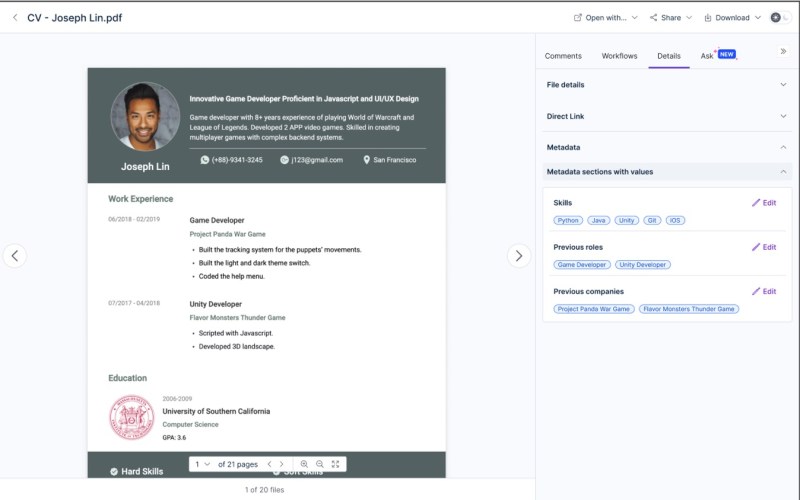Managers are under more pressure to drive productivity, and ironically efficiencies created by generative artificial intelligence (AI) tools are a big part of why expectations are growing.
At the same time, organizations face a crisis of trust from employees who see AI as a threat to their jobs.
In fact, generative AI is expected to replace some part of the workforce in the years ahead. As much as 29% of computer-related tasks could be automated by AI, as well as 28% of work by healthcare practitioners and technical tasks in that field, according to a study by Goldman Sachs.
Most experts agree, however, that newer AI tools are less about replacing people and more about eliminating mundane, manual, or number-crunching tasks that most employees already hate. In fact, the technology will mostly help free up workers to tackle more important jobs such as project management, reach more potential customers and handle more creative tasks.
A lot of the uncertainty and fear workers feel about generative AI tools is based on ignorance, experts say. AI, in its many forms, has been around for more than 50 years, but many people simply don’t recognize it’s been beside them all this time.
“People have always been afraid of AI because the vision they have of it is science fiction; it’s a Hollywood vision of it,” said Erick Brethenoux, a distinguished vice president analyst at research firm Gartner. “There’s a lot of hype around it. [But] generative AI is 95% of the airwaves and only 5% of the AI practices.”
AI, for example, has been used to automate credit card approvals and transactions — and anyone who’s used a GPS system has used AI to determine their routes. But in the past six or so months, new generative AI platforms such as ChatGPT have placed a spotlight on the technology and added a plethora of new use cases.
Generative AI, for instance, has been and can be used in decision support, decision augmentation, and decision automation.
“Decision augmentation, that’s what’s interesting; it’s the collaboration of humans and machines working together.” Brethenoux said. “I cannot analyze 7,000 dimensions at once. Machines can do that. So, then, great — let them analyze the data and find the patterns. Then how to apply those patterns can be at my discretion and could also be helped by a machine.”
For example, Brethenoux said his brother works in real estate and has five agents working for him. He has been using ChatGPT to analyze multiple property profiles, a task that would typically take up to six weeks if done manually. ChatGPT, Brethenoux said, can do that same task in an hour and a half. Instead of using the efficiencies of ChatGPT to reduce his workforce, his brother said the technology has freed up agents to be more hands-on and discover more prospective buyers.
“Right away, he thought, ‘What can my people do that machines cannot do?’” Brethenoux said.
Gartner also has a European client that’s preparing to launch an AI-enabled sales tool that listens into sales calls and, once a sale is made, automatically sends all the documentation needed to the prospect in order to close the deal.
Salespeople love the app because it frees them up from busy work and allows them to make at least twice as many calls to prospects per day, and they don’t have to worry about completing paperwork because it’s all done in the background by a bot.
“So they can focus on what they like to do: selling,” Brethenoux said. “That’s a great example of a human-machine collaboration.”
Generative AI can be used to find patterns in data, such as relationships between companies, people, and products for the purpose of uncovering money-laundering schemes. Machine learning algorithms have been used by telecom providers to monitor calls and messages and then suggest to sales reps what special deals can be offered to customers to prevent churn.
Still, Brethenoux acknowledges that employees are fearful they’ll lose their jobs to AI automation, whether it’s a valid fear or not.
“I believe in the large majority of cases, generative AI does not replace jobs, but tasks. Within a job you have many tasks, and one of them may be replaced,” he said.
“AI will not replace people. People who are using AI will replace people,” said Brethenoux, quoting Harvard Business School professor Karim Lakhani.
That’s why it’s beomcing increasingly important for business leaders and others to reassure staffers that generative AI and other forms of AI and machine learning are being deployed as task assistants, not worker replacements.
The lack of worker trust
More than a quarter of desk workers don’t think their employers trust them, according to research published last month by Slack. Those who do feel trusted show a better work experience and significantly better performance, reporting two times higher productivity.
“If employees don’t feel trusted, they’re not going to be comfortable with a new idea,” said Jeffrey Stier, who heads up consulting firm Ernst & Young’s (EY) Purpose and Vision Realized program for the Americas. “They’ll naturally be worried their jobs will be replaced. If you show them it is a tool that helps augment their jobs, they’ll see AI will give them more time to do creative things.”
Slack commissioned IT consultancy Qualtrics to survey more than 18,000 desk workers in nine countries at every rung of the corporate ladder. The survey data indicates that the majority of business leaders (71%) feel immense pressure to squeeze more productivity out of their teams.
At the same time, companies that have adopted AI are 90% more likely to report higher levels of productivity than those who have not, and workers save an average of 3.6 hours a week, according to the study. Those findings are often lost on employees who never see the data.
Slack, for example, is rolling out AI platforms to create efficiencies, including a workflow builder to automate tasks such as onboarding new employees and enabling management of worker calendars. The company is also experimenting with ChatGPT as a way to create summaries of internal conversations over its platform.
“We see jobs changing and new investments like AI happening, and we can understand how employees feel overwhelmed and concerned about job security,” said Christina Janzer, Slack’s head of Research and Analytics. “An important role the manager plays is as a source of truth. Share updates, invite feedback.”
That’s not, however, happening nearly enough, Janzer said. “Employees don’t have basic information to do their job,” she said.
Cultivating a culture of transparency and feedback
One key to reducing stress about AI deployments is to be upfront about what is being rolled out — and why. Managers should actively seek employee input not only about how they feel about the AI tools, but how the tech could help them do their jobs better. After all, most often it’s the workers who understand their jobs the best.
Janzer believes as AI becomes more common, it will be a key enabler of productivity by taking over mundane tasks and freeing workers to dedicate more time to strategic thinking and creative duties.
Research shows AI can free up as much as one working month per year, per employee, according to Janzer.
AI is also a valuable tool to uncover who is performing their jobs effectively and who isn’t. EY’s Stier, who’s responsible for architecting, co-designing, and developing the training and delivery for four EY leadership platforms, said his company is piloting its own version of a chatbot powered by ChatGPT to perform bi-weekly surveys of employees.
The surveys give managers insights to head off potential problems along with valuable personal information to better place employees based on existing skillsets. Resumes, for example, only show work expierence and technical capabilities. Stier said when he’s interviewing potential hires, he sees a resume as a limited piece of the information puzzle and typically ignores them.
“What a resume fails to tell you is what that person believes in as an individual; what’s important to them,” Stier said. “Where do they want to go in their careers? What do they want the company culture to be about?
“So, we’re building AI tools now because AI, and particularly chat, is a series of well-designed prompts that get answers to queries. If you and I are having a conversation and I want to know what inspires you to get up every day and go to work, that’s a prompt; it’s not on your resume, necessarily. Those are the things I want to know,” he said.
Many companies see AI as a tool to simply discover or cull lists of potential new hires. AI for HR, Stier pointed out, is much more sophisticated than just a hiring and firing tool; it can be used to build greater relationships with existing employees so they stay put. Every time an employee quits, it costs a company like EY tens or hundreds of thousands of dollars, depending on their seniority, Stier said.
EY, for example, is building out chatbots to create “net belonging scores,” which use employee survey answers to match data about what extraciricular activities they’re involved in and in what areas of the company they have opted to work — finance, leadership, strategy. Then a more comprehensive employee profile is created that goes beyond what HR records typically contain.
“So, you want to mitigate attrition and increase retention. Generative AI, using some of the techniques I’ve mentioned, can do that,” Stier said. “We’re experimenting with AI to make employees feel the company cares about them. You can use AI to do that by collecting more data points about personal purpose and personal career goals and adjust benefits, programs and which teams the employee is on.”
EY research has also found that employees are spending about a third of their time on performative tasks; these are tasks they do to appear productive,” Stier continued. “AI is for the people who we’ve hired to be the A and B performers; it’s going to help them do their jobs. We’re starting to give classes to employees on how use AI to increase their own efficiency.”
Generation Zs and Millenials want to know that they fit in, that they’re valued for more than just the skills they learned in school, according to Stier — something he called “the humanization of the workforce.”
Conversely, AI can also be used to expose so-called C- and D- and F-grade employees, those who are either not performing well or are simply in the wrong job.
“There’s no quiet quitting anymore because AI is going to be able sniff you out,” Stier said. “At the end of the day, that’s a good thing for employees, because that’s a bad way to go into the workforce, and it’s bad for employers. If you’re an employee who is not performing well, we’d much rather you come and share that with us right away, rather than have an AI tool find that. We’ve hired you for a certain reason.”
Copyright © 2023 IDG Communications, Inc.
Source link










Leave a Reply